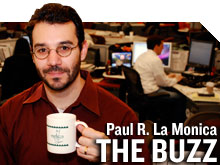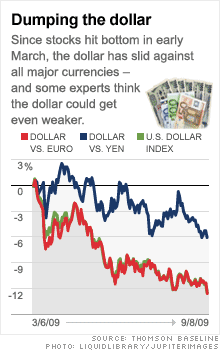Holler if you like the dollar. Anyone?
Investors are shunning the greenback in favor of stocks, commodities and other currencies. Can the dollar keep falling for much longer?


NEW YORK (CNNMoney.com) -- Who said investing was hard?
If you look at how the financial markets have behaved over the past six months, it seems like there is a pretty simple way to make money: buy stocks and commodities and sell the dollar.
I'm being a bit glib, of course. But the dollar continues to weaken against the euro, yen and a basket of other currencies as stocks and commodities such as oil, gold and silver keep rallying.
Since the stock market bottomed (hopefully) back on March 6, the greenback is down about 13% against the euro. And with the euro having crashed through the $1.45 barrier this week, it's reasonable to wonder just how much further the dollar could slide.
Is $1.50 in the cards anytime soon? Heck, is it even reasonable to think that the euro could get close to last year's record high of nearly $1.61?
It's unlikely that the dollar will fall that low against the euro. But several currency experts said there is no good reason to expect the dollar will rally anytime soon.
As long as stocks head higher on optimism about a global recovery, there's less of a reason to buy the dollar, which benefited last year primarily from a perception that it was the safest of safe havens.
"The principal reason for the latest decline in the dollar has been sentiment. The stock markets have performed very well this summer and the appetite for risk has returned," said Michael Woolfolk, senior currency strategist with Bank of New York Mellon. "And this week, professional traders are back from the summer doldrums. The bet is for a continuation of the stock rally."
With that in mind, Woolfolk said the dollar sell-off probably has legs and that it wouldn't be out of the question for the euro to hit $1.50 against the greenback at some point.
Richard Ross, global technical strategist with Auerbach Grayson, a broker dealer based in New York, said he thinks the dollar could fall another 6% to 8% against the U.S. Dollar Index (DXY), which tracks the dollar versus the euro, yen and four other currencies.
"In the short-term the picture for the dollar looks bearish. The recent breakdown opens the door for more moves down," Ross said.
So should consumers and the average investor worry about the weak dollar? On the one hand, the dollar's malaise is bad news if you're thinking of traveling to Europe or Asia anytime soon or if you buy imported goods.
But even if you, like most Americans, have pulled back on such discretionary spending, a weak dollar could hit you hard if it leads to higher energy prices this fall and winter.
It's no coincidence that oil hit a record high in July 2008 at the same time the dollar was at its lowest point against the euro. Oil and other commodities are priced in dollars -- so the weaker the greenback gets, the more expensive these commodities become.
Still, the dollar's slide could also have a big positive impact on corporate earnings for the third quarter. Since July, the greenback has lost about 3% of its value versus the euro, for example.
With that in mind, big U.S. companies with a heavy presence overseas, such as McDonald's (MCD, Fortune 500), Procter & Gamble (PG, Fortune 500), Intel (INTC, Fortune 500) and Exxon Mobil (XOM, Fortune 500) to name a few, could wind up getting a boost to profits as they translate revenue generated in other countries back into sales denominated by U.S. dollars.
"As the dollar weakens, multinationals benefit and the S&P 500 moves higher accordingly. Improvements in the economy are being mirrored by improvements in stocks and profits," Ross said.
So a weak dollar isn't necessarily a complete negative. But it's still hard to be excited about the dollar's anemic state.
That's because even though one reason the dollar may be falling is because of good economic news, concerns about inflation and the government's response to the recession are also hurting the greenback.
Between all the financial bailouts of the past year and the $787 billion stimulus package, the White House is now predicting a budget deficit of $9 trillion over the next 10 years. The government has been raising more money through the issuance of new Treasury bonds.
"The stock market is going up so the perceived safety of the dollar is less attractive to investors. But more importantly, the dollar is going down because of Economics 101," said Anthony Welch, co-manager of The Currency Fund, a mutual fund specializing in foreign exchange investments. "We keep printing more and more dollars and taking on more debt. There's more supply than demand."
Woolfolk isn't as worried about the deficit. He said deficit spending is necessary to keep the economy from slumping even further and that if the recovery is for real, deficits should naturally diminish as tax revenue from corporations and individuals bounce back.
But Woolfolk is concerned that the dollar could remain sluggish as long as the Federal Reserve holds short-term interest rates near zero and continues to buy up Treasurys in order to keep a lid on longer-term rates.
The latter practice, a phenomenon known as quantitative easing, is contributing to the dollar's weakness because it makes higher-yielding currencies more attractive.
"The problems the dollar has right now are 0% interest rates and quantitative easing. Once the Fed signals that it is going to remove some of these accommodative polices, then you could see the dollar rebound," Woolfolk said.
The Fed's next policy meeting is a two-day session that wraps up on September 23. Until then, there's little to suggest that the dollar will rally -- even though you'd think that sooner or later momentum will have to shift.
"The most crowded trade right now is to short the dollar," said Welch. "But every once in a while the crowd is correct. There is no reason to buy the dollar now."
Talkback: Recovery or runaway inflation? Is the dollar's weakness good news or bad news? Share your comments below. ![]()


